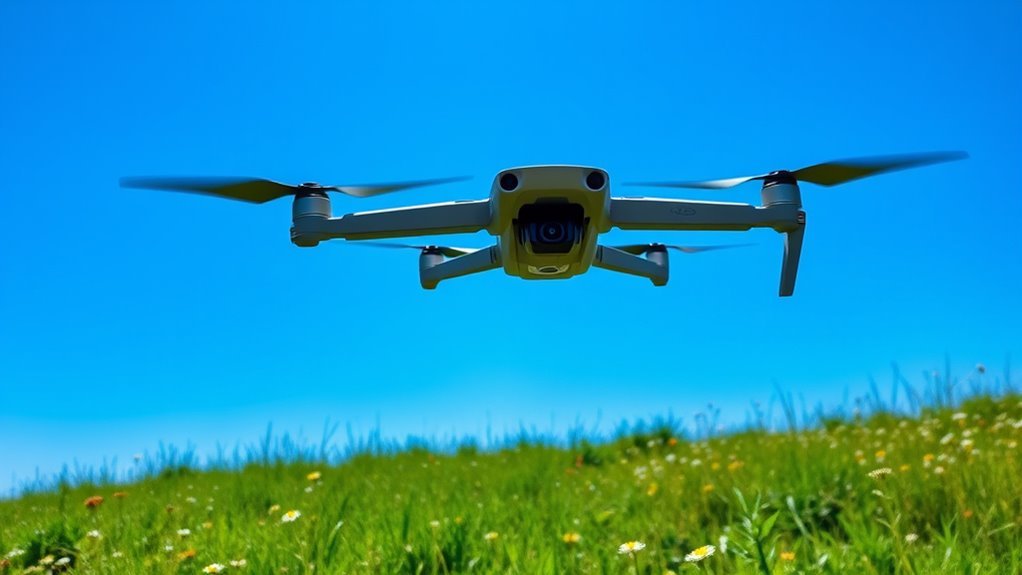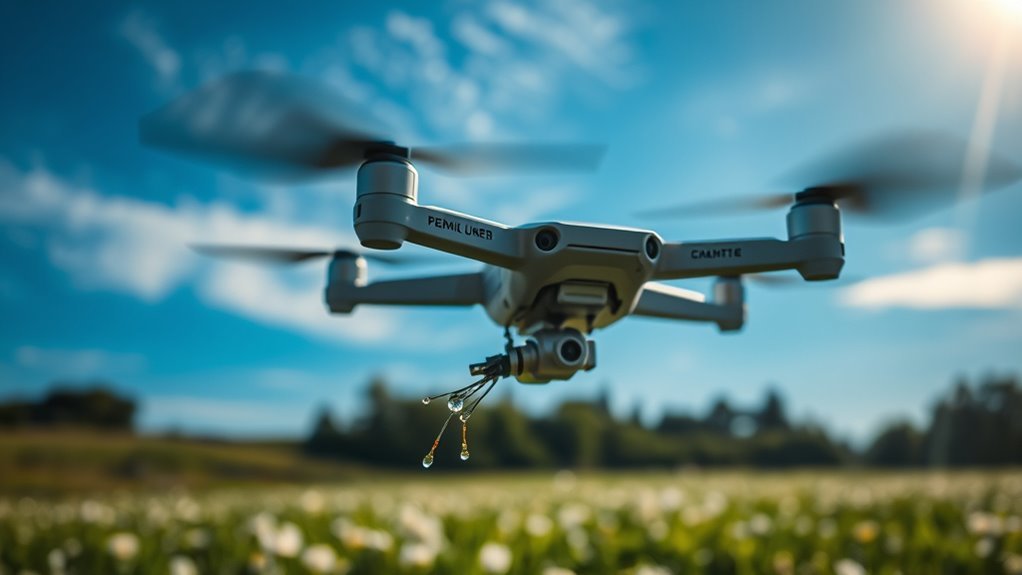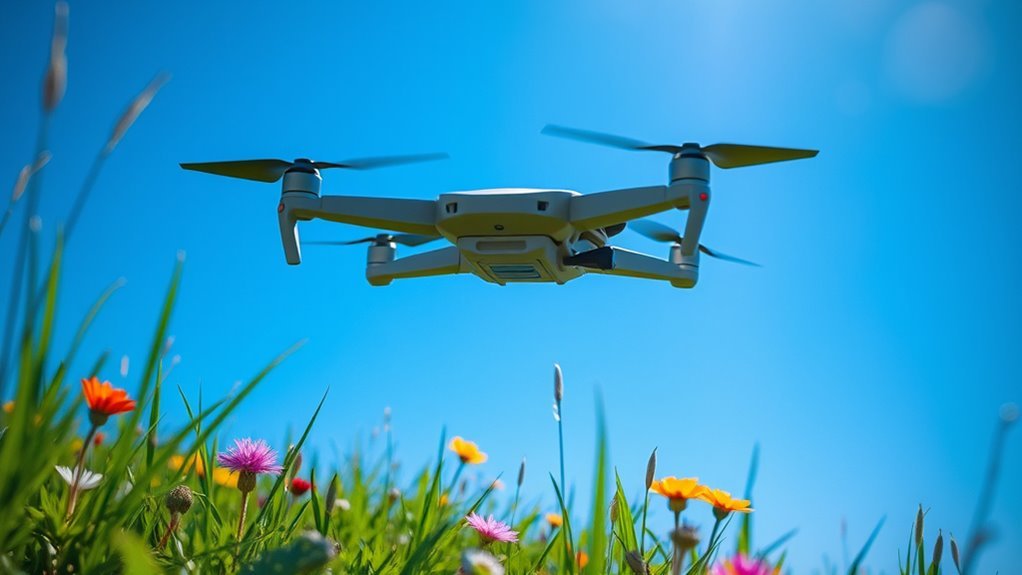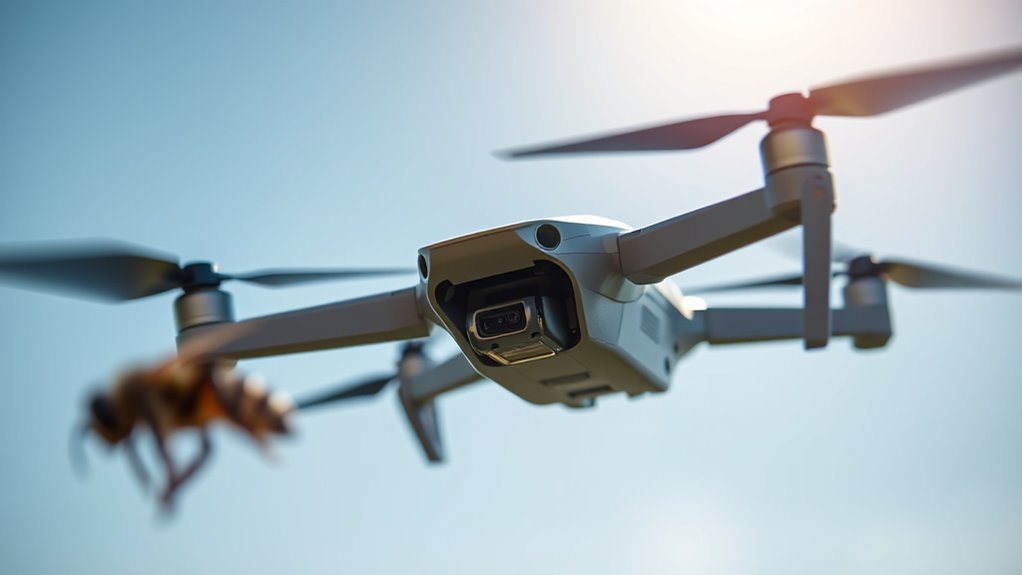Yes, drones can be equipped with stinging mechanisms that enhance their operational capabilities. These stingers allow drones to engage targets precisely, enabling applications in fields like agriculture, security, and military operations. They improve mission success rates by allowing swift, accurate actions against threats, while maintaining minimal collateral damage. However, there are challenges and ethical considerations to keep in mind. Explore further to understand the implications, innovations, and future of stinger-equipped drones in various industries.
Understanding Drone Technology

As you explore the domain of drone technology, it is important to recognize that these unmanned aerial vehicles (UAVs) are not merely flying machines; they are complex systems integrating various components and technologies. Understanding drone components such as propulsion systems, sensors, and communication devices is essential for leveraging their capabilities. For instance, high-resolution cameras facilitate aerial surveillance, allowing for real-time data collection and analysis. Additionally, the integration of GPS technology enhances navigation and positioning accuracy, critical for mission success. The interplay between these components enables drones to perform diverse tasks, from environmental monitoring to security applications. By grasping these fundamentals, you can appreciate the versatility and potential of drones in various fields, empowering your pursuit of freedom through technology. Moreover, advancements in obstacle avoidance technology ensure safer flights and reduce the risk of collisions. Furthermore, understanding battery life and its impact on range can significantly enhance your operational effectiveness and extend the distance drones can cover.
The Concept of Stinging Mechanisms

While drones are primarily designed for surveillance, delivery, and various industrial tasks, the concept of stinging mechanisms introduces a fascinating dimension to their capabilities. These mechanisms could mimic drone biology, enhancing drones’ functionality in ways previously unimagined.
| Mechanism Type | Functionality | Potential Applications |
|---|---|---|
| Electromagnetic | Disrupts electronics | Defense against threats |
| Chemical Release | Targeted pest control | Agricultural efficiency |
| Physical Impact | Precision strikes | Tactical operations |
Current Innovations in Drone Design

As you explore current innovations in drone design, you’ll notice significant advancements in payload capabilities that allow for more versatile applications. Additionally, swarming technology developments enable drones to operate cohesively, enhancing their effectiveness in various scenarios. Finally, enhanced navigation systems are improving autonomy and precision, thereby expanding operational potential in complex environments. Furthermore, the integration of advanced AI and autonomous systems is revolutionizing drone efficiency in enterprise operations, particularly through AI-enhanced obstacle avoidance that significantly increases flight safety and operational reliability.
Advanced Payload Capabilities
Innovations in drone design have greatly enhanced their payload capabilities, enabling a broader range of applications across various industries. With advanced engineering, drones can now execute precise payload delivery, whether for medical supplies in remote areas or vital reconnaissance missions. These developments offer significant tactical advantages, allowing for swift, efficient operations without risking personnel. The integration of modular payload systems permits customization, enabling you to adapt drones for specific missions. Enhanced sensors and AI-driven technology guarantee that payloads are not just delivered but effectively utilized, maximizing operational impact. The result is a versatile tool that empowers freedom in logistics and tactical operations, making drones indispensable in modern applications. Your ability to leverage these advancements can redefine effectiveness in your endeavors.
Swarming Technology Developments
The advancements in payload capabilities have set the stage for the development of swarming technology in drones, which enables multiple units to operate in coordinated formations. This technology leverages swarm intelligence, allowing drones to communicate and adapt collectively, mimicking natural phenomena seen in flocks and schools. By employing algorithms that foster collaborative behavior, drones can efficiently cover large areas, perform complex tasks, and respond dynamically to changing environments. This not only enhances operational effectiveness but also promotes autonomy, granting you the freedom to deploy drones in diverse scenarios without direct oversight. As these innovations progress, expect to see swarming technology revolutionize fields such as agriculture, surveillance, and disaster response, expanding the possibilities of drone applications.
Enhanced Navigation Systems
While traditional navigation systems have served their purpose, recent developments in enhanced navigation technologies are greatly improving drone performance and reliability. GPS advancements now enable drones to achieve centimeter-level accuracy, allowing for more precise positioning and route planning. These improvements empower you to navigate complex environments with confidence. Additionally, advanced obstacle avoidance systems utilize LiDAR and computer vision to detect and navigate around obstacles in real-time. This integration not only enhances safety but also expands operational capabilities in challenging terrains. As these technologies evolve, you’ll have greater freedom to deploy drones in various applications, from agriculture to search-and-rescue missions, without the constant worry of collisions or navigational errors. Enhanced navigation systems are paving the way for a new era in drone autonomy.
Potential Applications of Drones With Stingers
As drones continue to evolve, their integration with stingers presents intriguing potential applications across various fields. In agriculture, stinger technology could facilitate precision pest control, allowing drones to target specific areas with minimal chemical use. In security, these drones could serve as deterrents against unauthorized access, deploying stingers to incapacitate intruders without lethal force. In search and rescue operations, stinger-equipped drones could deliver essential supplies or create temporary barriers in emergency scenarios. Additionally, the military could leverage these drone applications for non-lethal crowd control, ensuring compliance without excessive force. As you explore these possibilities, consider the implications of stinger technology on operational efficiency and ethical concerns in various sectors, ultimately enabling a balance between innovation and responsibility.
Advantages of Stinger-equipped Drones
Stinger-equipped drones offer significant advantages in both target engagement and operational versatility. You can achieve precise strikes on enemy assets while maintaining a safe distance, enhancing your tactical options. This capability not only improves mission effectiveness but also expands the range of scenarios where drones can be effectively deployed.
Enhanced Target Engagement
Equipping drones with Stinger missiles greatly enhances their target engagement capabilities, allowing for precise strikes against a variety of threats. With advanced target acquisition systems, these drones can identify and lock onto targets with remarkable accuracy, minimizing collateral damage. The integration of Stinger missiles provides a vital advantage in dynamic combat environments, where rapid decision-making is essential. You’ll appreciate the agility and responsiveness that armed drones offer, enabling operators to engage targets swiftly and effectively. In addition, the Stinger’s high precision guarantees that threats are neutralized without compromising the safety of surrounding assets. This capability not only increases mission success rates but also aligns with the principles of operational freedom, granting you the ability to act decisively against adversarial forces.
Increased Operational Versatility
While the integration of Stinger missiles into drone platforms considerably enhances their operational versatility, it also opens up a broad spectrum of tactical applications. You’ll notice that these drones can engage ground and aerial threats with remarkable agility, ensuring operational efficiency in dynamic environments. The ability to launch Stinger missiles from unmanned systems allows for rapid response to emerging threats without risking personnel. This not only provides tactical advantages in combat scenarios but also enables intelligence, surveillance, and reconnaissance missions to seamlessly shift into strike capabilities. By utilizing Stinger-equipped drones, you gain a multi-dimensional approach to warfare, enhancing strategic flexibility and elevating mission success rates. Ultimately, this increased operational versatility empowers you to adapt to evolving battlefield conditions effectively.
Challenges and Limitations
Although drones offer innovative capabilities, their integration with stingers presents significant challenges and limitations. You’ll encounter payload limitations that restrict the types of stingers that can be effectively deployed. Design challenges arise as engineers must balance size and weight while maintaining functionality. Technical constraints also complicate the development process, often leading to performance trade-offs that may undermine operational effectiveness. In addition, integration issues between drone systems and stinger technology can create operational hurdles that hinder real-time responsiveness. Safety concerns must be addressed, particularly regarding unintended engagements. Finally, regulatory barriers can stifle innovation, as compliance with varying laws complicates deployment strategies. These factors collectively shape the feasibility of integrating stingers into drone systems, challenging the quest for enhanced autonomy and capability.
Ethical Considerations in Drone Design
As the integration of drones with stinger technology advances, ethical considerations become increasingly vital in the design process. You must recognize the ethical implications of deploying drones equipped with potentially lethal capabilities. It’s not just about the technology; it’s about your design responsibilities. You need to assess how your innovations might impact civilian safety and privacy. The potential for misuse raises questions about accountability and the moral ramifications of autonomous systems. Balancing freedom and security becomes essential, as you navigate the fine line between enhancing operational efficiency and safeguarding human rights. Ultimately, responsible design should prioritize ethical standards, ensuring that technological advancements serve the greater good without compromising individual freedoms or ethical integrity.
Regulatory Landscape for Drone Use
Understanding the regulatory landscape for drone use is vital, especially as technological advancements create new opportunities and challenges. You’ll find that various regulatory frameworks govern drone operations, often varying greatly by region. Drone legislation typically addresses safety, privacy, and airspace management, aiming to balance innovation with public interest. Familiarizing yourself with these regulations is essential for responsible drone use. For instance, in the U.S., the FAA outlines specific guidelines that drone operators must follow. As you navigate this landscape, staying informed on changes in legislation will empower you to seize opportunities while ensuring compliance. Awareness of these regulations not only enhances operational freedom but also fosters public trust in drone technology.
Future of Drones in Various Industries
The future of drones across various industries looks promising, driven by advancements in technology and increasing demand for efficient solutions. You’ll see drones evolving in areas like logistics, agriculture, and security, emphasizing drone sustainability and drone security. Recent innovations in AI-driven algorithms have significantly enhanced the decision-making capabilities of these drones.
| Industry | Key Application | Future Outlook |
|---|---|---|
| Logistics | Package delivery | Autonomous systems |
| Agriculture | Crop monitoring | Precision farming |
| Security | Surveillance | Enhanced data analytics |
As these industries adopt drone technology, expect improved operational efficiencies and reduced environmental impact. Embracing innovations will guarantee a balance between performance and sustainability, allowing you to leverage drones for a secure and eco-friendly future. The potential is immense, and the time to adapt is now. Moreover, advancements in safety feature standards will play a crucial role in shaping the future landscape of drone applications.
Frequently Asked Questions
Can Drones Actually Sting Like Insects?
Drones can’t sting like insects, but some drone designs incorporate insect mimicry for enhanced functionality. While they may mimic movements or appearances, they lack biological mechanisms to deliver a sting, prioritizing technological advancements over biological features.
What Materials Could Be Used for Drone Stingers?
When considering stinger design, materials like carbon fiber or advanced polymers offer excellent material durability. These choices guarantee peak performance and resilience, allowing you to explore innovative applications while maintaining the necessary strength and flexibility in drone technology.
How Would Stingers Affect Drone Weight and Flight?
A stitch in time saves nine; adding stingers impacts a drone’s weight distribution, potentially compromising flight stability. You’d need to carefully balance payload and performance to maintain efficiency and agility in the skies.
Are There Any Legal Restrictions on Drone Stingers?
You need to contemplate the legal implications of adding stingers to drones. Many countries have strict drone regulations that prohibit weaponization, so make sure you understand local laws before modifying your equipment for freedom’s sake.
How Would Maintenance Work for Drones With Stingers?
Maintaining drones equipped with stingers presents unique challenges. You’ll need regular drone upkeep to guarantee functionality, monitor stinger deployment systems, and conduct thorough inspections, as any malfunction could compromise operational effectiveness and safety.

